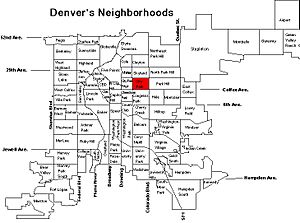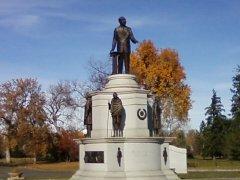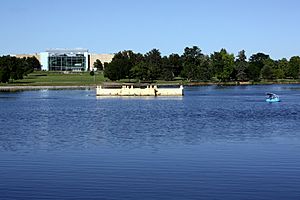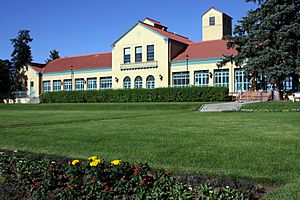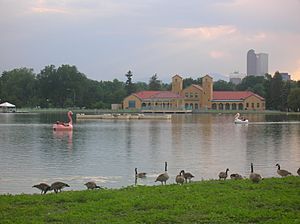City Park, Denver facts for kids
Quick facts for kids |
|
|
City Park
|
|

The Denver skyline from City Park in January
|
|
| Location | Denver, Colorado |
|---|---|
| Area | 330 acres (130 ha) |
| Built | 1880 |
| Architect | Meryweather, Henry F.; DeBoer, S.R. |
| Architectural style | Classical Revival, Renaissance, Shingle Style |
| MPS | Denver Park and Parkway System TR |
| NRHP reference No. | 86002190 |
| Added to NRHP | September 17, 1986 |
City Park is a huge park and a neighborhood in Denver, Colorado. It's like a giant green space right in the middle of the city! The park is about 330 acres (130 ha) big. That's like 250 football fields!
Inside City Park, you'll find exciting places like the Denver Zoo and the Denver Museum of Nature and Science. There are also two pretty lakes, Ferril Lake and Duck Lake, and a cool boathouse. City Park is the biggest park in Denver.
Where is City Park?
City Park is located in the eastern part of central Denver. It's just over a mile east of the downtown area. The park is about a mile long and three-quarters of a mile wide.
The park's edges are:
- West: York Street
- South: 17th Avenue
- East: Colorado Boulevard
- North: 23rd Avenue
The neighborhood called "City Park" has almost the same boundaries. It stretches a bit further south to Colfax Avenue. This area also includes East High School and a green space called the City Park Esplanade. This esplanade helps connect the park south to Colfax Avenue.
There's also a neighborhood called "City Park West" right next to the park on its western side. It's often known as Uptown.
A Look Back: City Park's History
When Denver started in 1858, it was a small mining town. But by the 1870s, many people lived there. They really wanted parks! In 1878, Colorado's government allowed Denver to get land for parks. City Park became the largest piece of land turned into a park.
The first design for City Park was made in 1882 by Henry Meryweather. He wanted it to look like the beautiful English gardens and even Central Park in New York City. It had a natural, flowing design. Later, the "City Beautiful movement" helped make the park even better.
City Park is one of Denver's oldest public spaces. People in Denver, including business owners and garden clubs, worked hard to improve the dry city. They dreamed of a big park in the east connected to a park in the west by tree-lined roads.
Richard Sopris, who managed the park from 1881 to 1891, is often called the "father of the park." Building the park began in 1886. They created winding roads and paths that gave the park its peaceful feeling. Many of these paths are still there today!
Around the early 1900s, the park got even more amazing. It was connected to a bigger system of parks using grand roads. Big statues and fancy gateways were added to the park entrances. These included the McLellan Gateway and the Thatcher Memorial Fountain.
Many designers helped shape the park over the years. S.R. DeBoer was very important. He was the city's landscape architect for almost 50 years, until 1960. After 1960, the Denver Zoo and the Denver Museum of Nature and Science grew a lot. Both of these places have been in the park for a long time and make it special.
In the 1990s, the park's Pavilion and other historic buildings like the Graham-Bible House (where the park caretaker lived) became local landmarks.
In 1997, people started planning how to make the park even better. They wanted to fix traffic and parking. This led to the "Revitalizing the Legacy of City Park" plan in 2001. Since then, many improvements have been made. Sculptures and fountains have been fixed, and the lakes look better.
By the early 1900s, Ferril Lake, the Denver Zoo, and the famous boathouse were all built. The boathouse has a cool Spanish-style design. Reinhard Schuetze, a German landscaper, helped make the park's design more formal. He planted gardens and created lovely carriage ways.
The first part of the Denver Museum of Nature and Science was finished in 1903. It was built on the highest spot in the park. This spot is famous for its amazing views of downtown Denver and the mountains! The museum opened to the public on July 1, 1908.
On April 23, 1916, a special tree called the Shakespeare Elm was planted. It came from a tree near William Shakespeare's grave in England!
When City Park first opened, it was a mile away from the rest of Denver. Trolleys helped people get to the park. The neighborhood around the park grew over time. It wasn't until the early 1900s, with better trolley connections, that many houses were built. The neighborhood has many historic brick homes and buildings, including East High School, which was built in 1925.
City Park Today
Today, the area around Colfax Avenue in the City Park neighborhood is very popular. It has many cool restaurants, stores, and businesses.
City Park is still Denver's most important park. Thousands of people visit it every year to enjoy the park and its attractions. In the summer, the park hosts free concerts. You can also rent paddle boats on Ferril Lake. Some boats are even shaped like pelicans and ducks! The boathouse can be rented for parties and events.
Ferril Lake has a special Prismatic Fountain that dates back to 1908. It was very advanced for its time. Now, the fountain has modern LED lights that change colors and patterns. Each light show lasts for an hour.
Images for kids


